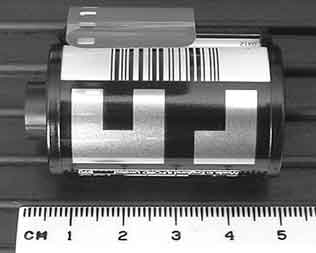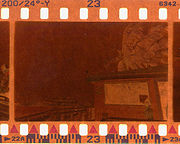
DX encoding
Encyclopedia

American National Standards Institute
The American National Standards Institute is a private non-profit organization that oversees the development of voluntary consensus standards for products, services, processes, systems, and personnel in the United States. The organization also coordinates U.S. standards with international...
and I3A standard, originally introduced by Kodak in March 1983, for marking 135
135 film
The term 135 was introduced by Kodak in 1934 as a designation for cartridge film wide, specifically for still photography. It quickly grew in popularity, surpassing 120 film by the late 1960s to become the most popular photographic film format...
and APS
Advanced Photo System
Advanced Photo System is a film format for still photography first produced in 1996. It was marketed by Eastman Kodak under the brand name Advantix, by FujiFilm under the name Nexia, by AgfaPhoto under the name Futura and by Konica as Centuria.- Design :The film is 24 mm wide, and has three...
photographic film and film cartridges. It has several parts, a latent image
Latent image
A latent image on photographic film is an invisible image produced by the exposure of the film to light. When the film is developed, the area that was exposed darkens and forms a visible image...
DX film edge barcode on the film below the sprocket holes, a code on the cartridge used by automatic cameras, and a barcode on the cartridge read by photo-finishing machines.
DX cartridge barcode
Next to the film exit lip is an Interleaved 2 of 5Interleaved 2 of 5
Interleaved 2 of 5 is a continuous two-width barcode symbology encoding digits. It is used commercially on 135 film and on cartons of some products, while the products inside are labeled with UPC or EAN....
barcode
Barcode
A barcode is an optical machine-readable representation of data, which shows data about the object to which it attaches. Originally barcodes represented data by varying the widths and spacings of parallel lines, and may be referred to as linear or 1 dimensional . Later they evolved into rectangles,...
and a printed number which represent the I3A assigned DX number
DX number
The DX number is assigned by the International Imaging Industry Association . It uniquely identifies the type and manufacturer of a film emulsion. A proprietary list of DX numbers for APS and 135 film is prepared yearly or as needed....
, the number of exposures and a proprietary manufacturer's code. The DX number identifies the manufacturer, film type, and by inference, the necessary developing process type. This is used by automatic photo-finishing machines to correctly process the exposed film. (Kodak US patent 4965628)
DX film edge barcode

DX Camera Auto Sensing
The outside of film cartridges are marked with a DX Camera Auto Sensing (CAS) code readable by many cameras. Cameras can then automatically determine the film speedFilm speed
Film speed is the measure of a photographic film's sensitivity to light, determined by sensitometry and measured on various numerical scales, the most recent being the ISO system....
, number of exposures and exposure tolerance. The first cameras to use the technology are said to be the Konica TC-X SLR and Pentax Super Sport 35 (PC 35AF-M) in 1984.
The DX Camera Auto Sensing code takes the form of a grid of contact points on the side of the metal cartridge surface that are either conductive or non-conductive. Electrical contacts in the camera read the bit pattern. Most cameras read only part of the code; typically, only the film speed is read, and some cameras aimed at the consumer market only read enough bits to tell apart the most common film speeds. For example 100, 200, 400, and 800 can be detected by reading only S1 and S2 and ground.
Electrical contacts
On 35mm film cartridges there are two rows of six rectangular areas. The two left-most areas (with the spool post on the left) are both common (ground) and are thus always bare metal. The remaining 5 bits in the top row represent 32 possible film speeds. But only the 24 speeds representing the 1/3 stopsF-number
In optics, the f-number of an optical system expresses the diameter of the entrance pupil in terms of the focal length of the lens; in simpler terms, the f-number is the focal length divided by the "effective" aperture diameter...
from ISO 25/15° to 5000/38° are used. The codes are not in strict binary order.
In the second row, the first 3 bits represent 8 possible film lengths, although in practice only 12, 20, 24 and 36 exposures are encoded. The remaining 2 bits of the second row give 4 ranges of exposure tolerance, or latitude.
Diagramatically (with spool post to the left):
| G | S1 | S2 | S3 | S4 | S5 |
| G | L1 | L2 | L3 | T1 | T2 |
Where "G" are the two common-ground contacts, "S" is the film speed, "L" the film length, and "T" the exposure tolerance.
Reading DX codes
| ISO speed | 1st row DX contacts | |||||
|---|---|---|---|---|---|---|
| 25/15° | ||||||
| 32/16° | ||||||
| 40/17° | ||||||
| 50/18° | ||||||
| 64/19° | ||||||
| 80/20° | ||||||
| 100/21° | ||||||
| 125/22° | ||||||
| 160/23° | ||||||
| 200/24° | ||||||
| 250/25° | ||||||
| 320/26° | ||||||
| 400/27° | ||||||
| 500/28° | ||||||
| 640/29° | ||||||
| 800/30° | ||||||
| 1000/31° | ||||||
| 1250/32° | ||||||
| 1600/33° | ||||||
| 2000/34° | ||||||
| 2500/35° | ||||||
| 3200/36° | ||||||
| 4000/37° | ||||||
| 5000/38° | ||||||
| custom 1 | ||||||
| custom 2 | ||||||
| custom 3 | ||||||
| custom 4 | ||||||
| custom 5 | ||||||
| custom 6 | ||||||
| custom 7 | ||||||
| custom 8 | ||||||
| Exposures | 2nd row DX contacts | |||||
|---|---|---|---|---|---|---|
| other | ||||||
| 12 | ||||||
| 20 | ||||||
| 24 | ||||||
| 36 | ||||||
| 48 | ||||||
| 60 | ||||||
| 72 | ||||||
| Exposure tolerance (in f-stops) |
2nd row DX contacts | |||||
|---|---|---|---|---|---|---|
| ±½ | ||||||
| ±1 | ||||||
| +2 -1 | ||||||
| +3 -1 | ||||||

